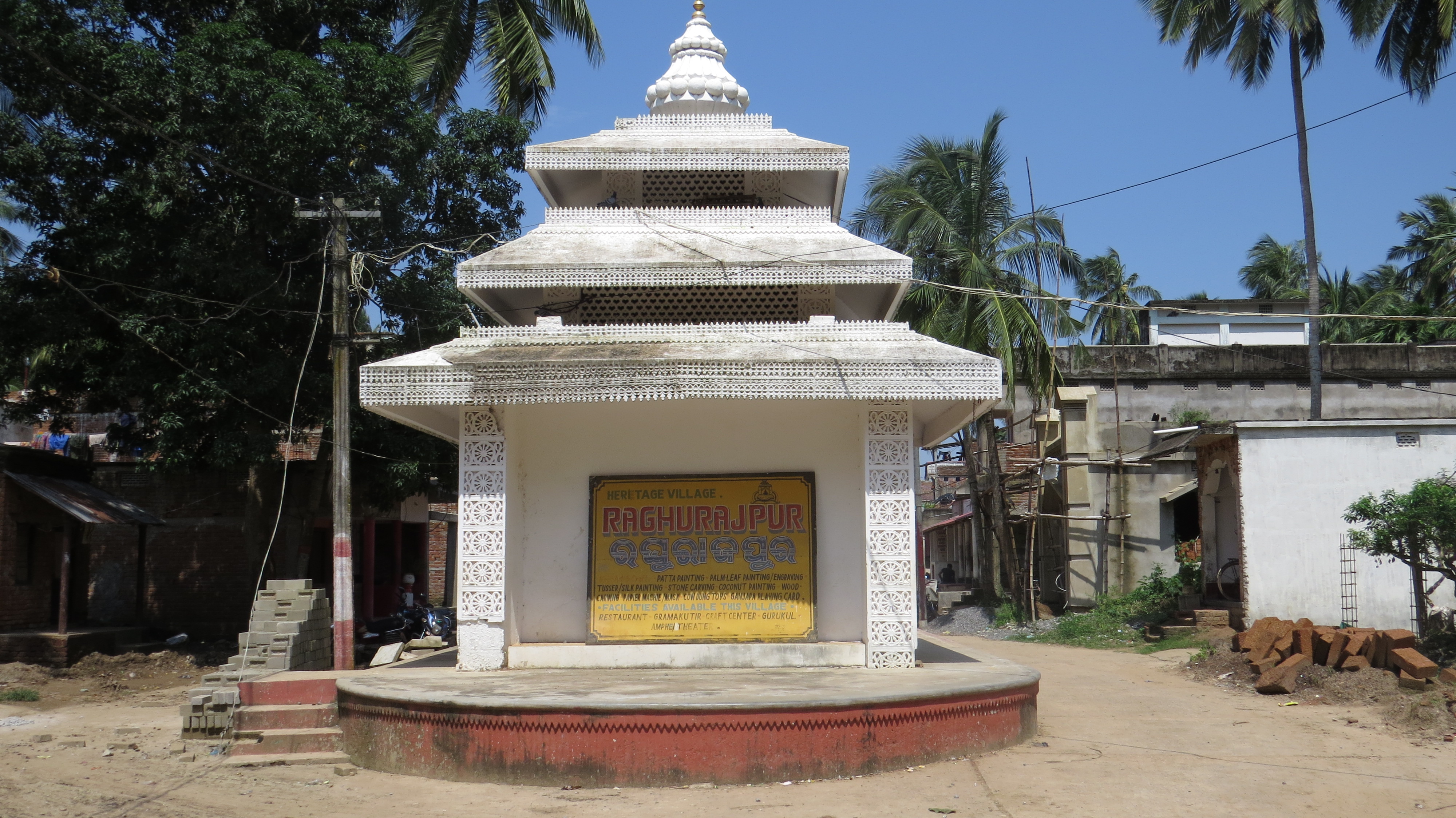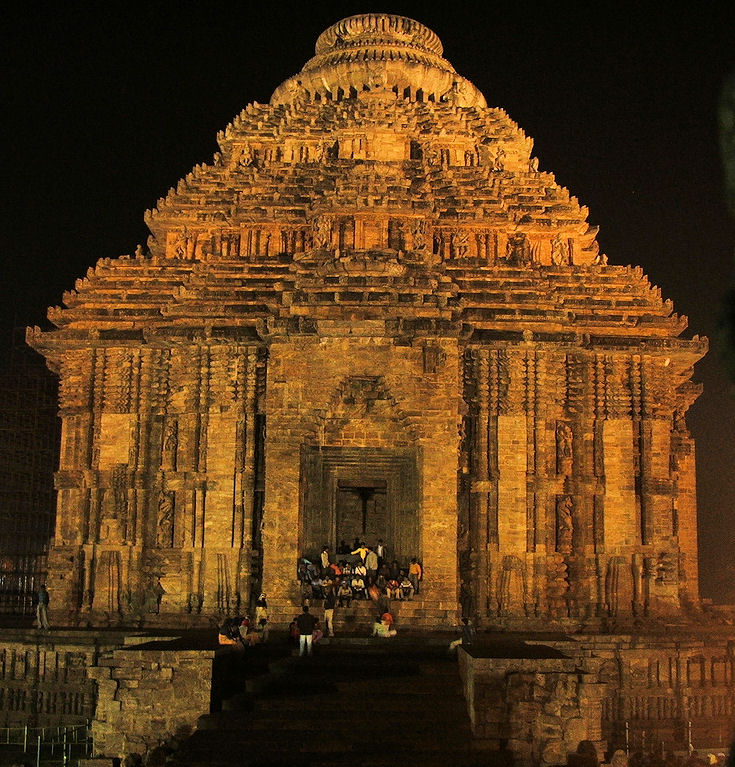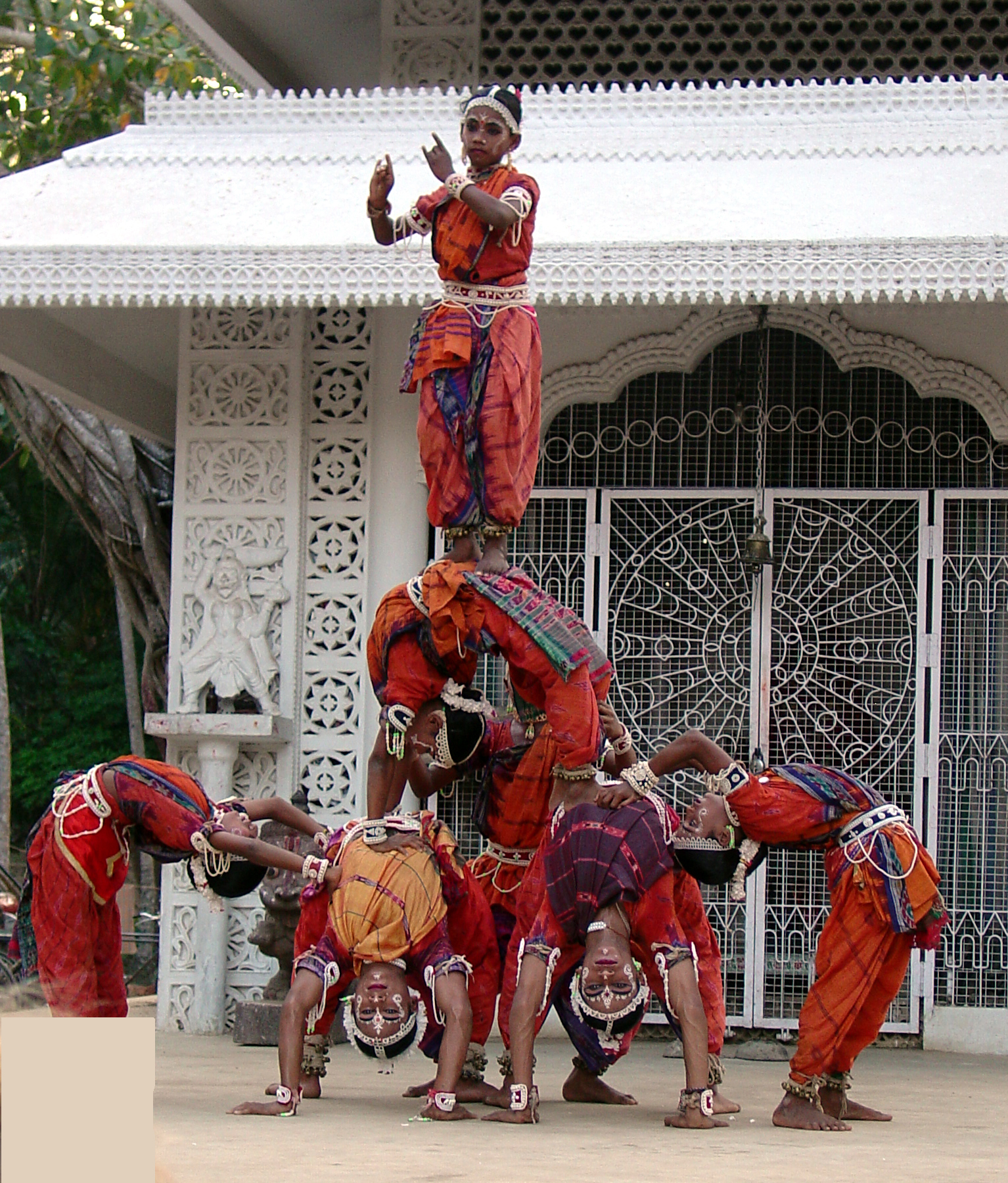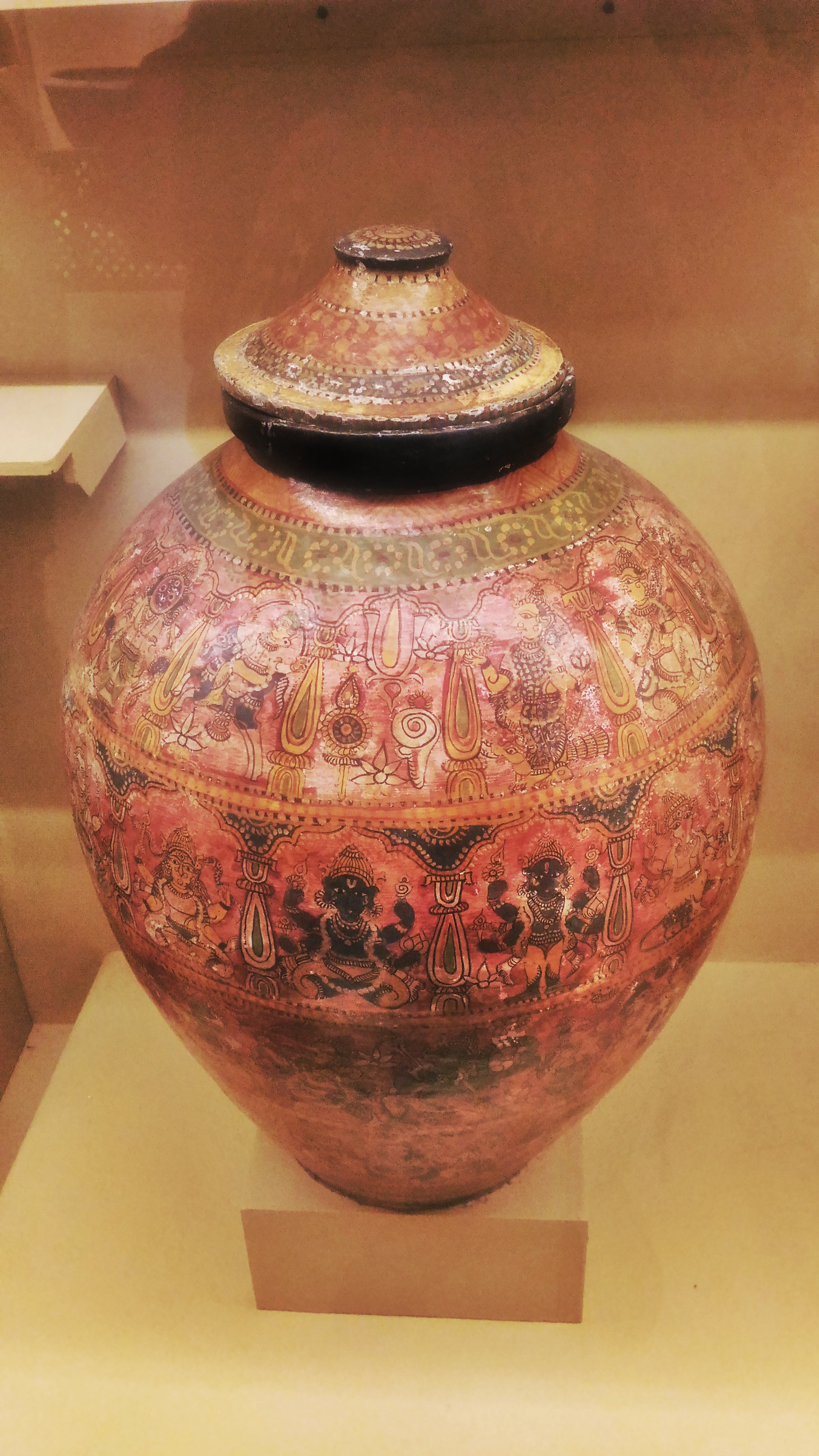|
Raghurajpur
Raghurajpur is a heritage crafts village out of Puri district, India, known for its master Pattachitra painters, an art form which dates back to 5 BC in the region and Gotipua dance troupes, the precursor to the Indian classical dance form of Odissi. It is also known as the birthplace of one of the finest and Legendary Odissi exponents Padma Vibhushan Guru, Kelucharan Mohapatra and Gotipua Dancer Padma Shri Guru, Maguni Charan Das. It is also the birth place of Shilp Guru Dr. Jagannath Mahapatra who is a prominent Pattachitra Artist and has a huge contribution on the development of Pattachitra art and Raghurajpur village. Apart from that, the village is also home to crafts like Tussar paintings, Palm leaf Engravings, Stone carvings, Wood carvings, Cowdung toys and Papier mache toys, and masks. Bindloss, p. 648 In 2000, after a two-year research and documentation project by INTACH, starting 1998, the village was chosen to be developed as state's first heritage village an ... [...More Info...] [...Related Items...] OR: [Wikipedia] [Google] [Baidu] |
Puri District
Puri district is a coastal district of the Odisha state of India. It has one sub-division, 11 tahasils and 11 blocks and comprises 1722 revenue villages. Puri is the only municipality of the district. Konark, Pipili and Nimapara are the three NACs in this district. Satyabadi, Gop, Kakatpur and Brahmagiri are major semi-urban areas. Name The district is named after its capital city, Puri. In Sanskrit, the word "Puri" means town or city. The city is an important seat of Vaishnavism, and is home to the noted Jagannath Temple built by Anantavarman Chodaganga in the mid 12th century CE. History Pre-history Like many other parts of Odisha, the Puri district contains Pleistocene river gravels and silts. So far, no prehistoric stone tools have been found in this region, although they are found in similar formations (river gravels, secondary laterite pits and murrams) in the nearby districts of Dhenkanal, Mayurbhanj, Kendujhar and Sundergarh. Early records In the dramatic ... [...More Info...] [...Related Items...] OR: [Wikipedia] [Google] [Baidu] |
Gotipua
Gotipua is a traditional dance form in the state of Odisha, India, and the precursor of Odissi classical dance. It has been performed in Orissa for centuries by young boys, who dress as women to praise Jagannath and Krishna. The dance is executed by a group of boys who perform acrobatic figures inspired by the life of Radha and Krishna. The boys begin to learn the dance at an early age until adolescence, when their androgynous appearance changes. In the Odia language, Gotipua means "single boy" (''goti-pua''). Raghurajpur, Odisha (near Puri) is a historic village known for its Gotipua dance troupes. The dance of the Gotipuas is accompanied by traditional Odissi music with the primary percussion being the Mardala. Dancers To transform into graceful feminine dancers the boys do not cut their hair, instead they style it into a knot and weaving garlands of flowers into it. They make up their faces with mixed white and red powder. ''Kajal'' (black eyeliner) is broadly applied arou ... [...More Info...] [...Related Items...] OR: [Wikipedia] [Google] [Baidu] |
Maguni Charan Das
Maguni Charan Das was an Indian traditional dancer of Gotipua, a traditional dance form of Odisha. Life He was the founder of ''Dasabhuja Gotipua Odishi Nrutya Praishad'', a school for Gotipua dance where the art form is taught in the traditional Gurukul way. Born in Raghurajpur, in Puri district of the Indian state of Odisha, he is known to have contributed to the revival of Gotipua tradition, which is widely considered as the precursor of the classical dance form of Odissi. His style of performance is known as the ''Raghurajpur Gharana'' of Gotipua and his school provides training in the dance discipline, while taking care of the academic education of the students. He was a recipient of Odisha Sangeet Natak Akademi Award and Tulsi Award. The Government of India awarded him the fourth highest civilian honour of the Padma Shri, in 2004, for his contributions to Gotipua dance. Das died on 5 December 2008. See also * Gotipua *Mardala Mardala () is a classical percussive ins ... [...More Info...] [...Related Items...] OR: [Wikipedia] [Google] [Baidu] |
Pattachitra
Patachitra or Pattachitra is a general term for traditional, cloth-based scroll painting, based in the eastern Indian states of Odisha, West Bengal and parts of Bangladesh. Patachitra artform is known for its intricate details as well as mythological narratives and folktales inscribed in it. Pattachitra is one of the ancient artworks of Odisha, originally created for ritual use and as souvenirs for pilgrims to Puri, as well as other temples in Odisha. Patachitras are a component of an ancient Bengali narrative art, originally serving as a visual device during the performance of a song. Etymology In the Sanskrit, ''paṭṭa'' means "cloth" and ''chitra'' means "picture". Most of these paintings depict stories of Hindu deities. Odisha Pattachitra Pattachitra is a traditional painting of Odisha, India.http://odisha.gov.in/e-magazine/Orissareview/2010/November/engpdf/46-48.pdf These paintings are based on Hindu mythology and specially inspired by Jagannath and Vaishnava s ... [...More Info...] [...Related Items...] OR: [Wikipedia] [Google] [Baidu] |
Pattachitra
Patachitra or Pattachitra is a general term for traditional, cloth-based scroll painting, based in the eastern Indian states of Odisha, West Bengal and parts of Bangladesh. Patachitra artform is known for its intricate details as well as mythological narratives and folktales inscribed in it. Pattachitra is one of the ancient artworks of Odisha, originally created for ritual use and as souvenirs for pilgrims to Puri, as well as other temples in Odisha. Patachitras are a component of an ancient Bengali narrative art, originally serving as a visual device during the performance of a song. Etymology In the Sanskrit, ''paṭṭa'' means "cloth" and ''chitra'' means "picture". Most of these paintings depict stories of Hindu deities. Odisha Pattachitra Pattachitra is a traditional painting of Odisha, India.http://odisha.gov.in/e-magazine/Orissareview/2010/November/engpdf/46-48.pdf These paintings are based on Hindu mythology and specially inspired by Jagannath and Vaishnava s ... [...More Info...] [...Related Items...] OR: [Wikipedia] [Google] [Baidu] |
Kelucharan Mohapatra
Kelucharan Mohapatra (8 January 1926 – 7 April 2004) was a legendary Indian classical dancer, guru, and exponent of Odissi dance, who is credited with the revival and popularizing of this classical dance form in the 20th century. He is the first person to receive the Padma Vibhushan from Odisha. A noted Sanskrit poet of India writes on this ''Guru'': ''Saango-paanga-subhangi-laasya-madhuram samteerna-nrutyaarnavam'', which translates as - "Each fraction of his dancing body leads to paramount sweetness, through miraculous poses and postures. In fact, Guru Kelucharan Mohapatra crossed the ocean of styles." Early life and history In his youth, Kelucharan Mohapatra performed Gotipua - a traditional dance form of Odisha where young boys dress up as woman to praise Lord Jagannath. Later in his life he did extensive research on Gotipua and Mahari dance, which lead him to restructure Odissi dance. Guru Kelucharan Mohapatra was a master in Percussion instruments - Mardala and ... [...More Info...] [...Related Items...] OR: [Wikipedia] [Google] [Baidu] |
INTACH
The Indian National Trust for Art and Cultural Heritage (INTACH) is a non-profit charitable organisation registered under the Societies Registration Act, 1860. In 2007, the United Nations awarded INTACH a special consultative status with United Nations Economic and Social Council.INTACH gets special status for its efforts '' The Hindu'', 30 October 2007. History INTACH was founded in 1984 in New Delhi with the vision to create a membership organisation to stimulate and spearhead heritage awareness and conservation in[...More Info...] [...Related Items...] OR: [Wikipedia] [Google] [Baidu] |
Sambalpuri Saree
A Sambalpuri sari is a traditional handwoven ''bandha'' (ikat) sari (locally called ''"sambalpuri bandha"'' sadhi or saree) wherein the warp and the weft are tie-dyed before weaving. It is produced in the Sambalpur, Balangir, Bargarh, Boudh and Sonepur districts of Odisha, India. The sari is a traditional female garment in the Indian subcontinent consisting of a strip of unstitched cloth ranging from four to nine metres in length that is draped over the body in various styles.Alkazi, Roshan (1983) "Ancient Indian costume", Art Heritage; Ghurye (1951) "Indian costume", Popular book depot (Bombay); Boulanger, Chantal; (1997) Sambalpuri saris are known for their incorporation of traditional motifs like shankha (shell), chakra (wheel), phula (flower), all of which have deep symbolism with the native Odia colour red black and white represent true Odia Culture along with Lord Kaalia (Jagannatha)'s face colour, but the highpoint of these saris is the traditional craftsmanship of the ' ... [...More Info...] [...Related Items...] OR: [Wikipedia] [Google] [Baidu] |
Hindu
Hindus (; ) are people who religiously adhere to Hinduism. Jeffery D. Long (2007), A Vision for Hinduism, IB Tauris, , pages 35–37 Historically, the term has also been used as a geographical, cultural, and later religious identifier for people living in the Indian subcontinent. The term ''"Hindu"'' traces back to Old Persian which derived these names from the Sanskrit name ''Sindhu'' (सिन्धु ), referring to the river Indus. The Greek cognates of the same terms are "''Indus''" (for the river) and "''India''" (for the land of the river). The term "''Hindu''" also implied a geographic, ethnic or cultural identifier for people living in the Indian subcontinent around or beyond the Sindhu (Indus) River. By the 16th century CE, the term began to refer to residents of the subcontinent who were not Turkic or Muslims. Hindoo is an archaic spelling variant, whose use today is considered derogatory. The historical development of Hindu self-identity within the local ... [...More Info...] [...Related Items...] OR: [Wikipedia] [Google] [Baidu] |
Laxminarayan
Lakshmi Narayana or Lakshmi-Narayan ( sa, लक्ष्मी-नारायण, IAST: ) is the dual representation of the Hindu deities Vishnu, also known as Narayana, and his consort, Lakshmi, traditionally featured in their abode, Vaikuntha. The goddess of prosperity and beauty, Lakshmi, is depicted as standing next to Vishnu, who holds the Panchajanya, Kaumodaki, Padma, and the Sudarshana Chakra. Another depiction of Lakshmi-Narayana portrays Lakshmi in the service of Narayana, who reclines on the cosmic serpent Shesha, floating in the Kshira Sagara, the Ocean of Milk. Legends The most significant Lakshmi-Narayana myth that appears in various Puranas is the Samudra Manthana, where Vishnu assumes his Kurma avatar to assist the devas and the asuras in the ordeal of churning the ocean of milk. Lakshmi emerges as one of the many treasures that are the product of the churning. The devas request Vishnu to marry her, and hence her auspiciousness is wed to his divinity, restorin ... [...More Info...] [...Related Items...] OR: [Wikipedia] [Google] [Baidu] |
Gouranga
Gauranga is another name for Chaitanya Mahaprabhu (or Gauranga Mahaprabhu), the 16th century Bengali avatar and founder of Gaudiya Vaishnavism. The term ''Gauranga Mahaprabhu'' references Lord Chaitanya possessing the golden complexion of Srimati Radharani as an incarnation or avatar of Krishna. Nomenclature * 'Gauranga' ( Bengali ; Sanskrit गौराङ्ग; IAST: Gaurāṅga) means 'having a white, yellowish, or golden complexion'. The term is a bahuvrihi compound from: **'Gaura' (Sanskrit गौर) which means 'fair', 'gold', 'yellow', and 'saffron' (in complexion) ** 'Anga' (or 'aGga', Sanskrit अङ्ग) which means 'limb', 'constituent', and 'component part' (of Krishna) Gaudiya Vaishnavism the term 'Gauranga' is relevant in Gaudiya Vaishnavism due to scriptural verses such as the following found in the ''Bhagavata Purana'': 'Krsna' (or 'Krishna', Sanskrit कृष्ण) means 'black'; 'Akṛṣṇam' ('a-krsna-m') means 'not black' or 'golden'. 'Gau ... [...More Info...] [...Related Items...] OR: [Wikipedia] [Google] [Baidu] |
The Hindu
''The Hindu'' is an Indian English-language daily newspaper owned by The Hindu Group, headquartered in Chennai, Tamil Nadu. It began as a weekly in 1878 and became a daily in 1889. It is one of the Indian newspapers of record and the second most circulated English-language newspaper in India, after ''The Times of India''. , ''The Hindu'' is published from 21 locations across 11 states of India. ''The Hindu'' has been a family-owned newspaper since 1905, when it was purchased by S. Kasturi Ranga Iyengar from the original founders. It is now jointly owned by Iyengar's descendants, referred to as the "Kasturi family", who serve as the directors of the holding company. The current chairperson of the group is Malini Parthasarathy, a great-granddaughter of Iyengar. Except for a period of about two years, when S. Varadarajan held the editorship of the newspaper, the editorial positions of the paper were always held by members of the family or held under their direction. His ... [...More Info...] [...Related Items...] OR: [Wikipedia] [Google] [Baidu] |






.jpg)
_in_the_Hoysaleshwara_temple_at_Halebidu.jpg)

